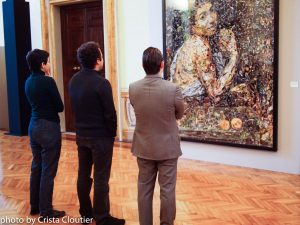
An artist’s life is a balancing act.
Managing finances for the art studio, honing one’s artistic skills, finding the right platform to showcase works of art, thinking of social promotion, and investing time within your local art community are challenging for every artist. Participation in art fairs is also a promotional strategy that needs equal focus.
Does a working artist really have the time and expertise to take on all these roles? Especially when, in the background, lurks the fear that the money you invest may never come back in sales.
The truth is that artists often struggle in times of economic crisis. There isn’t a safety net for most of us. Financial support and economic backing are constant pressure points affecting our dedication and creativity. Even emergency grants and mutual aid are just short-term solutions.
However, when artists share their resources in what we call a ‘cooperative movement’ you may find protection and support for your work.
Here’s some information about how a co-op art gallery may benefit you, as opposed to pay-for-display or vanity galleries.
Traditional Art Galleries vs Cooperative Art Galleries

Exhibiting your artwork in a fine-art gallery with an established clientele can increase the credibility of your creations. If you are just starting to sell your art or are unfamiliar with the area, the gallery’s support can boost the perceived value of your pieces among those who rely on the gallery for exceptional art. When the gallery endorses you and your work, they are backing their recommendation with their own reputation. Consequently, you gain a committed ally who shares a mutual interest in promoting and selling your art.
Stepping into the world of contemporary art may create a mixed bag of emotions. You love to create art but putting up your art for sale requires a business mind. There are two channels I want to discuss for reaching out to art consumers and collectors–art galleries for artists and cooperative art galleries.
A traditional fine-art gallery has an established clientele. Its pre-planned marketing and promotional efforts bring credibility to your work and reputation. The gallery’s status can elevate and endorse an artists’ work. It’s a powerful way to build your name within the art community.
But as an artist, you may not have complete control over the display of your work in the gallery exhibition. Your success may entirely depend on the gallery’s overall marketing plan and the commissions the gallery has set. It’s common for the art gallery’s commission to be between 40% to 50% of the sale price of your artwork – sometimes more. Be prepared to bear the downside of non-negotiable pricing while selling your art in traditional art galleries.
A co-op art gallery or an art cooperative is a group of artists working together. They make joint decisions as a shared collective. A co-op gallery’s ownership and decision-making are far more democratic than that of an art gallery. In an artist cooperative, you will have a better say on various details, whether art making, sales, or advertising. You can also keep more of your work’s sale price.
Working in a co-op art gallery stipulates each artist to devote fixed hours working in the gallery. In exchange, the percentage sharing of the ultimate price of your work gets reduced. Each art co-op has its shared responsibilities, work hours, and commissions.
These shared managerial skills are the beauty of a co-op art gallery. The co-op members discuss and agree upon every aspect of the group–from gathering office supplies, making work schedules, art display space allocation, marketing, even housekeeping. There is no top-down approach in a co-op art gallery, but hands-on sharing with more interaction and cooperation. A co-op art gallery almost redefines how to be an artist.
Integrating into a Art Co-op Gallery
Artists have the opportunity to engage with cooperatives to potentialize their creative endeavors.
If your artistic practice involves freelancing, consider establishing a worker-owned cooperative to share the costs of equipment or workspace, expand your professional connections, and collectively advocate for improved wages and working conditions.
You might also contemplate joining a studio cooperative, where everyone contributes to acquire and manage a shared studio space. Additionally, many artists opt to concentrate their cooperative initiatives on sales, events and gallery exhibitions.
By joining a a art co-op gallery, you can attract a larger audience and more potential buyers than if you were attempting to showcase your artwork independently.
Artist-owned cooperatives motivate artists who typically operate as independent freelancers, to collaborate with their peers. This collaboration allows them to combine their networks, share their collection of tools and equipment, and unite in marketing and promotion efforts.
Joining a worker-owned cooperative as a creative professional provides you with valuable insights and resources from various industries, which can aid in your career development and foster a sense of solidarity among workers.
Benefits Of Working In A Co-op Art Gallery

Most major cities have cooperative art galleries with different levels of required commitment.By showing your work together and sharing a percentage of the profits, you can hopefully expand your audience of buyers and curators.
Here is how a co-op gallery delivers:
- Becoming a member-artist in a co-op gallery can be a good way for new and upcoming artists to get exposure from the arts community and from the media. A co-op gallery works on community membership principles, not profit alone. So, young budding artists who do not have the experience and skillset to market their art can join a co-op gallery to hone their craft and grow their reputation, unlike a commercial gallery that may not accommodate your shortcomings.
- Working in a co-op gallery helps you learn about costs and logistics. You share the revenues with fellow co-op members. This type of experience will also help you make your mark in your profession as you will learn to understand the taste and expectations of local art buyers.
- There is a sense of community within a co-op gallery. You will collaborate with other artists and exchange thoughts on topics such as participation in upcoming art fairs.
- Getting associated with well-established co-op galleries will help you polish your art selling skills. You’ll learn the fundamentals of the art business.
- Established cooperative galleries often can reliably market artwork within the community.
During challenges such as the recent pandemic, artists’ resources are often stretched. Emergency grants are limited, and government funding policies may not be enough. Building an arts ecosystem through a co-op gallery can bring artists, curators, art galleries, and freelancers to level playing field and even help build collective power to improve the working conditions of artists.
Challenges Ahead

The co-op art galleries provide a broad canvas to promote a range of artists. But one cannot rule out the visible gaps in work culture and sales, as a co-op art gallery will most likely have seasoned both artists and newbies. Add to that, the co-op gallery’s demand for volunteering may eat up on your art studio time.
Because of the sales staff rotation at co-operative art galleries, prospective buyers may not get consistent service and follow-up to generate strong sales. Artists’ egos get hurt and there may be personality conflicts.
- Since co-op galleries provide a space for a diverse array of artists, the quality of artwork displayed in these galleries can vary significantly. You might find yourself exhibiting alongside some of the leading artists in your region, as well as those who are just starting their artistic journey.
- A cooperative gallery exhibit pieces by a wide array of artists. The higher the number of members, the more fees can be gathered to help cover expenses. Consequently, the gallery is driven to display as much artwork as it can from numerous artists, which may diminish the focus on any single artist.
- If you’re thinking about exhibiting in a co-op gallery, I recommend Establishing clear criteria to assess the effectiveness of your partnership with the gallery, and don’t hesitate to end the relationship if your expectations are not being fulfilled.
- Additionally, make sure to connect with the other artists who are part of the gallery. If there are opportunities to volunteer, take advantage of them. Attend openings for as many of your fellow artists as you can and encourage collectors to check out the gallery.
Final Thoughts on Cooperative Art Galleries
The key takeaway is simple: put yourself out into the world and engage! Go to exhibitions and events, offer your help for fundraising activities, and, above all, connect with others. You never know what opportunities may arise!
Being part of a gallery cooperative means you are less dependent on the preferences of curators and gallery owners. You no longer have to wait for their endorsement; instead, you create opportunities for yourself and your fellow co-op members.
Furthermore, if you get sales from a show at the co-op gallery, you won’t need to divide profits the way a gallery normally operates (although you will likely share a portion of the earnings with your fellow artists).
Additionally, your audience may be more likely to support artists associated with a co-op because they understand their contributions are going directly to the artists, rather than being processed through the traditional gallery system.
Though these challenges exist, I believe that joining a co-operative art gallery can be a powerful experience for any artist. But you must be a team player, and a generous one at that, in order to reap the rewards.
Learn how to approach to art-world decision makers, create revenue streams, and get paid more being who you are – an artist.
Join my list, it’s FREE, and I’ll share everything I know about working as an artist.
Working in the international world of contemporary art, Crista Cloutier has spent her career selling art and marketing art to art galleries, museums and private collections.
Using her professional experiences, Crista has created The Working Artist Masterclass, where she’s developed a global reputation as an artist’s coach. Crista can teach you how to be an artist; including how to sell your art, how to sell art online, how to sell photographs, how to price your art, how to succeed at art fairs, and even how to find your art style.
Crista has worked with established, blue-chip artists to raise their profile and attract greater opportunities. And she’s also helped thousands of emerging artists to build a professional art practice. To learn more, visit https://theworkingartist.com
